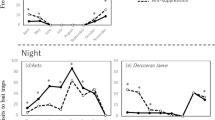Abstract
To examine which species of ant are underground predators, we invented a simple bait trap using live mealworms as bait. A total of 75 bait traps were buried in soil at various depths (10, 20, 30 and 50 cm) to investigate the vertical distribution of predatory ants. The ants captured in approximately 50% of the traps were mostlyTetramorium caespitum andSolenopsis japonica. Solenopsis japonica was captured at greater depths (>30 m) thanT. caespitum. Eight kinds of soil invertebrate (the earthworm, wood louse, pill bug, millipede, adults of the dung beetle and carabid beetle, larvae of a cetoniine beetle and the earwig), placed in traps at a depth of 10 cm, varied greatly in attractiveness and vulnerability to ant predation. The earthworm and the wood louse were both attractive and vulnerable to ant predation, whereas the pill bug, the dung beetle and the millipede were attractive but not vulnerable. The larvae of a cetoniine beetle, the carabid beetle and the earwig were mostly unattractive.
Similar content being viewed by others
References
Begon M., Harper J. L. &Townsend C. R. (1990)Ecology: Individuals, Population and Communities, 2nd ed. Blackwell Science, Boston.
Brian M. V. (1964) Ant distribution in a southern English heath.Journal of Animal Ecology 33: 451–461.
Brian M. V., Hibble J. &Stradling D. J. (1965) Ant pattern and density in a southern English heath.Journal of Animal Ecology 34: 545–555.
Brown V. K. &Gange A. C. (1990) Insect herbivory below ground.Advances in Ecological Research 20: 1–58.
Denno R. F., Larsson S. &Olmstead K. L. (1990) Role of enemy-free space and plant quality in host-plant selection by willow beetles.Ecology 71: 124–137.
Edmunds M. (1974)Defense in Animals. Longman Inc., New York.
Fowler S. V. &MacGarvin M. (1985) The impact of hairy wood ants,Formica lugubris, on the guild structure of herbivorous insects on birch,Betula pubescens.Journal of Animal Ecology 54: 847–855.
Kosaku A., Ishii N., Ito M., Sunami K., Hasegawa M. & Yamaguchi T. (1994) Changes in soil fauna at Ecology Park, Natural History Museum and Institute, Chiba: Sampling methods. In:Journal of the Natural History Museum and Institute, Chiba, Special Issue 1 (eds T. Nakamura & M. Hasegawa) pp. 267–276 (in Japanese with English summary).
Lawton J. H. &Strong D. R. Jr (1981) Community patterns and competition in folivorous insects.American Naturalist 118: 317–338.
Masuko K. (1984) Studies on the predatory biology of oriental Dacetine ants (Hymenoptera: Formicidae) I. Some Japanese species ofStrumigenys, Rentastruma andEpitritus, and a MalaysianLabidogenys, with special reference to hunting tactics in shortmandibulate forms.Insectes Sociaux 31: 429–451.
Otis G. W., Santana E. C., Craford D. L. &Higgins M. L. (1986) The effect of foraging army ants on leaf-litter arthropods.Biotropica 18: 56–61.
Paine R. T. (1966) Food web complexity and species diversity.American Naturalist 100: 65–75.
Risch S. J. &Carroll C. R. (1982) Effect of a keystone predaceous ant,Solenopsis geminata, on arthropods in a tropical agroecosystem.Ecology 63: 1979–1983.
Robinson M. H. (1969) Defenses against visually hunting predators.Evolutionary Biology 3: 225–259.
Teranishi C. (1929) Japanese ants, their behavior and distribution (II).Dobutugaku Zasshi 41: 312–332 (in Japanese).
Woodman R. L. &Price P. W. (1992) Differential larval predation by ants can influence willow sawfly community structure.Ecology 73: 1028–1037.
Wheeler W. M. (1910)Ants. Columbia University Press, New York.
Wilson E. O. (1959) Some ecological characteristics of ants in New Guinea rain forest.Ecology 40: 437–447.
Yamaguchi T. & Nakamura T. (1994) Changes in topography, soil structure and vegetation cover associated with restoration work at Ecology Park. In:Journal of the Natural History Museum and Institute, Chiba, Special Issue 1 (eds T. Nakamura & M. Hasegawa) pp. 19–31 (in Japanese with English summary).
Author information
Authors and Affiliations
Additional information
An erratum to this article is available at http://dx.doi.org/10.1007/BF02523616.
About this article
Cite this article
Yamaguchi, T., Hasegawa, M. An experiment on ant predation in soil using a new bait trap method. Ecol. Res. 11, 11–16 (1996). https://doi.org/10.1007/BF02347815
Received:
Accepted:
Issue Date:
DOI: https://doi.org/10.1007/BF02347815




